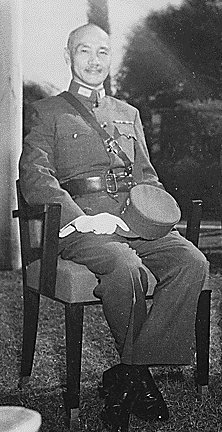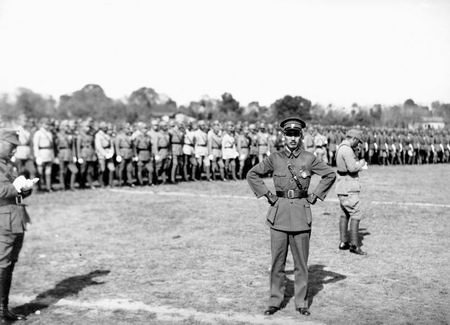|
Long March
The Long March (, lit. ''Long Expedition'') was a military retreat undertaken by the Chinese Red Army, Red Army of the Chinese Communist Party (CCP), the forerunner of the People's Liberation Army, to evade the pursuit of the National Revolutionary Army, National Army of the Kuomintang, Chinese Nationalist Party (CNP/KMT). Strictly speaking, the Long March was a series of marches, as various Communist armies in the south escaped to the north and west. However, the most famous began in the Jiangxi (Jiangxi) province in October 1934 and ended in the Shaanxi province in October 1935. The First Front Army of the Chinese Soviet Republic, led by an inexperienced military commission, was on the brink of annihilation by Generalissimo Chiang Kai-shek's troops in their stronghold in Jiangxi province. The CCP, under the eventual command of Mao Zedong and Zhou Enlai, escaped in a circling retreat to the west and north, which reportedly traversed over over 370 days.Zhang, Chunhou. Vaughan, ... [...More Info...] [...Related Items...] OR: [Wikipedia] [Google] [Baidu] |
Chinese Civil War
The Chinese Civil War was fought between the Kuomintang-led government of the Republic of China and forces of the Chinese Communist Party, continuing intermittently since 1 August 1927 until 7 December 1949 with a Communist victory on mainland China. The war is generally divided into two phases with an interlude: from August 1927 to 1937, the KMT-CCP Alliance collapsed during the Northern Expedition, and the Nationalists controlled most of China. From 1937 to 1945, hostilities were mostly put on hold as the Second United Front fought the Japanese invasion of China with eventual help from the Allies of World War II, but even then co-operation between the KMT and CCP was minimal and armed clashes between them were common. Exacerbating the divisions within China further was that a puppet government, sponsored by Japan and nominally led by Wang Jingwei, was set up to nominally govern the parts of China under Japanese occupation. The civil war resumed as soon as it bec ... [...More Info...] [...Related Items...] OR: [Wikipedia] [Google] [Baidu] |
Zhou Enlai
Zhou Enlai (; 5 March 1898 – 8 January 1976) was a Chinese statesman and military officer who served as the first Premier of the People's Republic of China, premier of the People's Republic of China from 1 October 1949 until his death on 8 January 1976. Zhou served under Chairman Mao Zedong and helped the Chinese Communist Party, Communist Party rise to power, later helping consolidate its control, form its Foreign policy of China, foreign policy, and develop the Economy of China, Chinese economy. As a diplomat, Zhou served as the Chinese Foreign Minister of the People's Republic of China, foreign minister from 1949 to 1958. Advocating peaceful coexistence with Western Bloc, the West after the Korean War, he participated in the Geneva Conference (1954), 1954 Geneva Conference and the 1955 Bandung Conference, and helped orchestrate 1972 Nixon visit to China, Richard Nixon's 1972 visit to China. He helped devise policies regarding disputes with the United States, Taiwan, the So ... [...More Info...] [...Related Items...] OR: [Wikipedia] [Google] [Baidu] |
Fifth Encirclement Campaign Against Jiangxi Soviet
The fifth encirclement campaign against Jiangxi Soviet, Kiangsi (Jiangxi) Soviet was a series of battles fought during the Chinese Civil War from 25 September 1933, to October 1934 between Chiang Kai-shek's Kuomintang, Chinese Nationalists (Kuomintang) and the Chinese Communist Party, Chinese Communists. During this campaign, the Kuomintang successfully overran the communist Chinese Soviet Republic and forced the Communists on the run, an event later known as the Long March. Chiang Kai-shek and the Nationalists termed this campaign the fifth encirclement campaign (; pinyin: dì wǔ cì wéijiǎo), whilst the Chinese Red Army, Communists termed it the fifth counter-encirclement campaign at the Central Soviet (; pinyin:zhōngyāng Sūqū dì wǔ cì fǎnwéijiǎo), also known as the fifth counter-encirclement campaign at the Central Revolutionary Base (; pinyin: Zhōngyāng gémìng gēnjùdì dì wǔ cì fǎnwéijiǎo) or fifth extermination campaign. Prelude After the failu ... [...More Info...] [...Related Items...] OR: [Wikipedia] [Google] [Baidu] |
Bo Gu
Qin Bangxian or Ch'in Pang-hsien (), better known as Bo Gu (; Wade-Giles: ''Po Ku''; May 14, 1907 – April 8, 1946) was a senior leader of the Chinese Communist Party and a member of the 28 Bolsheviks. Early life and education Qin was born in Wuxi, Jiangsu, in 1907. In his earlier years, Qin studied at the Suzhou Industrial School where he took an active role in activities against imperialism and the warlords tyrannizing China. In 1925 Qin entered Shanghai University, a university that was known for its impact on young revolutionists at the time. The ideas of Marxism and Leninism were taught there by early leaders of the Chinese Communist party like Qu Qiubai and Deng Zhongxia. Qin showed a great interest in these teachings. Later that year, Qin joined the May 30th Movement which called for protests and boycotts against imperialism. This was a precursor to his involvement in the CPC. In 1926 Qin was sent to the Moscow Sun Yat-sen University in Moscow, Russia where he continu ... [...More Info...] [...Related Items...] OR: [Wikipedia] [Google] [Baidu] |
Ningdu Conference
The Ningdu Conference () was a meeting of the Chinese Communist Party held in the Bangshan Ancestral Hall () in the village of Xiaoyuan (), Ningdu County, Jiangxi Province. The meeting took place in early October 1932 (possibly October 3–8Stuart_R._Schram_(ed.):_The_Pre-Marxist_Period,_1912-1920,_Volume_1,_M.E._Sharpe,_1997,_page_58/ref>),_shortly_after_the_successful_repulsion_of_the_Stuart_R._Schram">Stuart_R._Schram_(ed.):_The_Pre-Marxist_Period,_1912-1920,_Volume_1,_M.E._Sharpe,_1997,_page_58/ref>),_shortly_after_the_successful_repulsion_of_the_Kuomintang">Nationalists'_Third_Encirclement_Campaign_against_Jiangxi_Soviet.html" "title="Kuomintang.html" ;"title="Stuart R. Schram (ed.): The Pre-Marxist Period, 1912-1920, Volume 1, M.E. Sharpe, 1997, page 58">Stuart R. Schram">Stuart R. Schram (ed.): The Pre-Marxist Period, 1912-1920, Volume 1, M.E. Sharpe, 1997, page 58/ref>), shortly after the successful repulsion of the Kuomintang">Nationalists' Third Encirclement Campaign again ... [...More Info...] [...Related Items...] OR: [Wikipedia] [Google] [Baidu] |
Jiangxi–Fujian Soviet
The Central Revolutionary Base, commonly called the Central Soviet (Zone), the Kiangsi–Fukien Soviet, or the Jiangxi–Fujian Soviet, was the largest component territory of the Chinese Soviet Republic, an unrecognized state established in November 1931 by Mao Zedong and Zhu De during the Chinese civil war. Geographically, the Jiangxi–Fujian Soviet-occupied the mountainous parts of Jiangxi and Fujian provinces of China and was home to the town of Ruijin, the county seat and headquarters of the Chinese Soviet government. The Jiangxi-Fujian base area was defended ably by the First Red Front Army but in 1934 was finally overrun by the Kuomintang government's National Revolutionary Army in the Fifth of its Encirclement Campaigns. This last campaign in 1934-35 precipitated the most famous of the grand retreats known collectively as the Long March. Beginning On November 7, 1931, on the anniversary of the 1917 Russian Bolshevik Revolution, the Soviet Union helped organize a N ... [...More Info...] [...Related Items...] OR: [Wikipedia] [Google] [Baidu] |
Generalissimo
''Generalissimo'' ( ) is a military rank of the highest degree, superior to field marshal and other five-star ranks in the states where they are used. Usage The word (), an Italian term, is the absolute superlative of ('general') thus meaning "the highest-ranking of all generals". The superlative suffix itself derives from Latin , meaning "utmost, to the highest grade". Similar cognates in other languages include in Spanish, in Portuguese, in French, and in Latin. Historically this rank was given to a military officer leading an entire army or the entire armed forces of a state, usually only subordinate to the sovereign. The military leader Albrecht von Wallenstein in 1632 was the first imperial generalissimo (general of the generals). Other usage of the rank has been for the commander of the united armies of several allied powers and if a senior military officer becomes the head of state or head of government of a nation like Chiang Kai-Shek in China and later in ... [...More Info...] [...Related Items...] OR: [Wikipedia] [Google] [Baidu] |
National Revolutionary Army
The National Revolutionary Army (NRA; ), sometimes shortened to Revolutionary Army () before 1928, and as National Army () after 1928, was the military arm of the Kuomintang (KMT, or the Chinese Nationalist Party) from 1925 until 1947 in China. It also became the regular army of the Republican era during the KMT's period of party rule beginning in 1928. It was renamed the Republic of China Armed Forces after the 1947 Constitution, which instituted civilian control of the military. Originally organized with Soviet aid as a means for the KMT to unify China during the Warlord Era, the National Revolutionary Army fought major engagements in the Northern Expedition against the Chinese Beiyang Army warlords, in the Second Sino-Japanese War (1937–1945) against the Imperial Japanese Army and in the Chinese Civil War against the People's Liberation Army. During the Second Sino-Japanese War, the armed forces of the Chinese Communist Party were nominally incorporated into the Nation ... [...More Info...] [...Related Items...] OR: [Wikipedia] [Google] [Baidu] |
People's Liberation Army
The People's Liberation Army (PLA) is the principal military force of the People's Republic of China and the armed wing of the Chinese Communist Party (CCP). The PLA consists of five service branches: the Ground Force, Navy, Air Force, Rocket Force, and Strategic Support Force. It is under the leadership of the Central Military Commission (CMC) with its chairman as commander-in-chief. The PLA can trace its origins during the Republican Era to the left-wing units of the National Revolutionary Army (NRA) of the Kuomintang (KMT) when they broke away on 1 August 1927 in an uprising against the nationalist government as the Chinese Red Army before being reintegrated into the NRA as units of New Fourth Army and Eighth Route Army during the Second Sino-Japanese War. The two NRA communist units were reconstituted into the PLA on 10 October 1947. Today, the majority of military units around the country are assigned to one of five theater commands by geographical location. ... [...More Info...] [...Related Items...] OR: [Wikipedia] [Google] [Baidu] |
Chinese Red Army
The Chinese Workers' and Peasants' Red Army or Chinese Workers' and Peasants' Revolutionary Army, commonly known as the Chinese Red Army or simply the Red Army, are the armed forces of the Chinese Communist Party. It was formed when Communist elements of the National Revolutionary Army splintered and mutinied in the Nanchang Uprising. The Red Army was reincorporated into the National Revolutionary Army as part of the Second United Front with the Kuomintang to fight against the Japanese during the Second Sino-Japanese War. In the later stages of the Chinese Civil War. History Formation (late 1920s) In the summer of 1926, the CCP took over the two divisions of the Chinese Nationalist Party forces and led a military mutiny. Nationalist forces General He Long commanded the 20th Corps to join them. They had a total of 20,000 soldiers and planned to occupy Guangzhou. However, they were defeated before they reached Guangzhou with only a few thousand men surviving the battle ... [...More Info...] [...Related Items...] OR: [Wikipedia] [Google] [Baidu] |
Deng Xiaoping
Deng Xiaoping (22 August 1904 – 19 February 1997) was a Chinese revolutionary leader, military commander and statesman who served as the paramount leader of the People's Republic of China (PRC) from December 1978 to November 1989. After CCP chairman Mao Zedong's death in 1976, Deng gradually rose to supreme power and led China through a series of far-reaching market-economy reforms earning him the reputation as the "Architect of Modern China". He contributed to China becoming the world's second largest economy by GDP nominal in 2010. Born in the province of Sichuan in the Qing dynasty, Deng studied and worked in France in the 1920s, where he became a follower of Marxism–Leninism and joined the Chinese Communist Party (CCP) in 1924. In early 1926, Deng travelled to Moscow to study Communist doctrines and became a political commissar for the Red Army upon returning to China. In late 1929, Deng led local Red Army uprisings in Guangxi. In 1931, he was demoted within the ... [...More Info...] [...Related Items...] OR: [Wikipedia] [Google] [Baidu] |


.jpg)

.jpg)
.jpg)